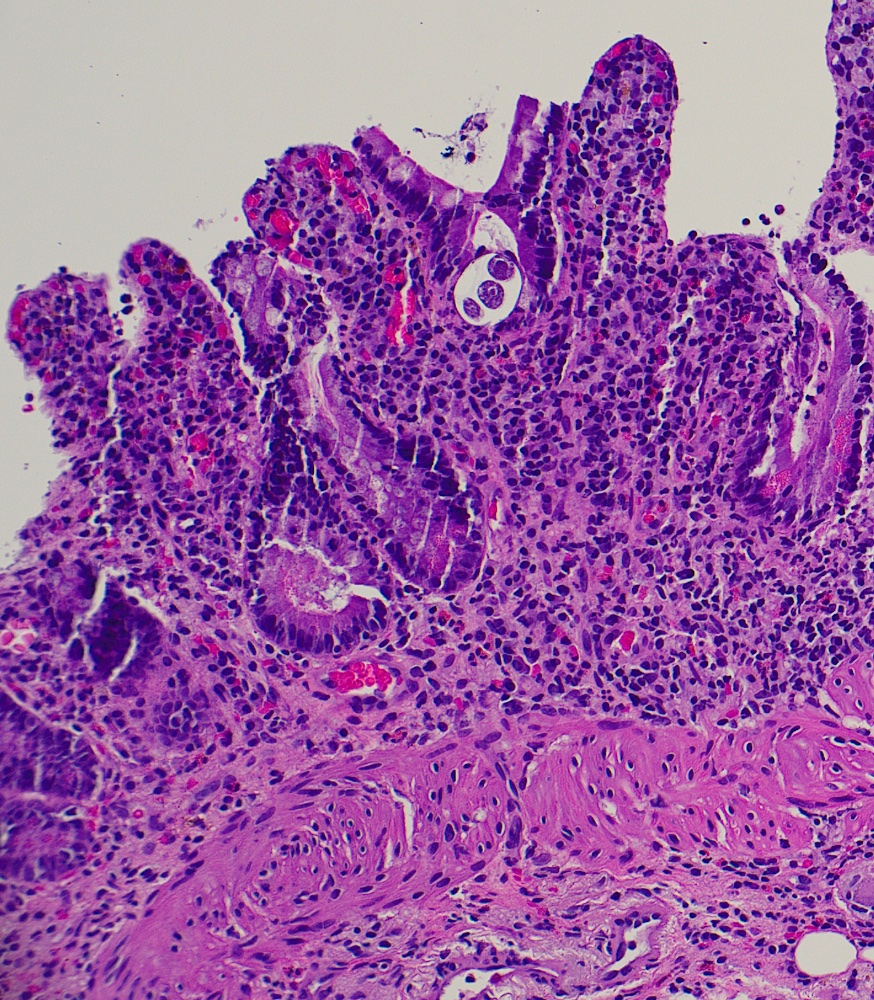Sunday Poster Session
Category: Infections and Microbiome
Trust Your Gut - Except If It’s <i>Strongyloides</i>
P1335 - Trust Your Gut - Except if It’s Strongyloides
Sunday, October 26, 2025
3:30 PM - 7:00 PM PDT
Location: Exhibit Hall

Urmimala Chaudhuri, DO
Wright State University
Centerville, OH
Presenting Author(s)
Urmimala Chaudhuri, DO1, Makul Sharma, BS2, Rawan Aljaras, MD2, Sangeeta Agrawal, MD2
1Wright State University, Centerville, OH; 2Wright State University Boonshoft School of Medicine, Dayton, OH
Introduction: Strongyloides stercoralis is an intestinal nematode that typically affects the small bowel and
often presents asymptomatically or with mild GI symptoms. In immunocompromised patients, it
can lead to serious complications such as hyperinfection syndrome. Gastric involvement is rare,
and presentation as gastric outlet obstruction (GOO) is even more uncommon. We present a
unique case of Strongyloides-associated GOO in a patient with a history of gastric cancer.
Case Description/
Methods: A 76-year-old male with history of poorly differentiated signet ring gastric adenocarcinoma
(status post robotic subtotal gastrectomy with gastro-jejunal anastomosis) was transferred from
an outside hospital for further evaluation of GOO. He presented with a one-week history of
nausea and poor oral intake. EGD was initially performed at the outside hospital and
demonstrated severe stenosis at the gastrojejunal junction (GJ), raising concern for near-
complete obstruction, which could not be traversed by a standard or an ultraslim endoscope,
prompting transfer for advanced management.
The patient underwent a repeat EGD which showed a severely edematous and inflamed GJ
anastomosis, and a large volume of retained gastric contents. Biopsies revealed Strongyloides
infection despite a negative stool ova and parasite screen. The patient was given one dose of
Ivermectin 9 mg and initiated on total parenteral nutrition (TPN) for three weeks. He was
discharged on TPN and scheduled for surgical revision of anastomosis. Unfortunately, he
passed away from pulmonary complications before surgery.
Discussion: Our case highlights a rare presentation for Strongyloides infection as GOO in a post-
gastrectomy patient. The patient’s immunosuppressed state from chemotherapy may have
predisposed him to this atypical presentation. Differentials for GOO include tumor recurrence,
stricture, inflammation, and rarely infection. Our case also highlights the challenges in
management, including the inability to traverse the stricture with endoscopes and unsuccessful
enteral access, necessitating TPN. Stronglyloides is one of the few parasites capable of
autoinfection, with hyperinfection syndrome carrying high mortality in immunosuppressed hosts.
Early recognition and treatment are critical.

Figure: Crypt-based Strongyloides stercoralis larva in small intestinal mucosa with surrounding eosinophilic inflammation (H&E)
Disclosures:
Urmimala Chaudhuri indicated no relevant financial relationships.
Makul Sharma indicated no relevant financial relationships.
Rawan Aljaras indicated no relevant financial relationships.
Sangeeta Agrawal indicated no relevant financial relationships.
Urmimala Chaudhuri, DO1, Makul Sharma, BS2, Rawan Aljaras, MD2, Sangeeta Agrawal, MD2. P1335 - Trust Your Gut - Except If It’s <i>Strongyloides</i>, ACG 2025 Annual Scientific Meeting Abstracts. Phoenix, AZ: American College of Gastroenterology.
1Wright State University, Centerville, OH; 2Wright State University Boonshoft School of Medicine, Dayton, OH
Introduction: Strongyloides stercoralis is an intestinal nematode that typically affects the small bowel and
often presents asymptomatically or with mild GI symptoms. In immunocompromised patients, it
can lead to serious complications such as hyperinfection syndrome. Gastric involvement is rare,
and presentation as gastric outlet obstruction (GOO) is even more uncommon. We present a
unique case of Strongyloides-associated GOO in a patient with a history of gastric cancer.
Case Description/
Methods: A 76-year-old male with history of poorly differentiated signet ring gastric adenocarcinoma
(status post robotic subtotal gastrectomy with gastro-jejunal anastomosis) was transferred from
an outside hospital for further evaluation of GOO. He presented with a one-week history of
nausea and poor oral intake. EGD was initially performed at the outside hospital and
demonstrated severe stenosis at the gastrojejunal junction (GJ), raising concern for near-
complete obstruction, which could not be traversed by a standard or an ultraslim endoscope,
prompting transfer for advanced management.
The patient underwent a repeat EGD which showed a severely edematous and inflamed GJ
anastomosis, and a large volume of retained gastric contents. Biopsies revealed Strongyloides
infection despite a negative stool ova and parasite screen. The patient was given one dose of
Ivermectin 9 mg and initiated on total parenteral nutrition (TPN) for three weeks. He was
discharged on TPN and scheduled for surgical revision of anastomosis. Unfortunately, he
passed away from pulmonary complications before surgery.
Discussion: Our case highlights a rare presentation for Strongyloides infection as GOO in a post-
gastrectomy patient. The patient’s immunosuppressed state from chemotherapy may have
predisposed him to this atypical presentation. Differentials for GOO include tumor recurrence,
stricture, inflammation, and rarely infection. Our case also highlights the challenges in
management, including the inability to traverse the stricture with endoscopes and unsuccessful
enteral access, necessitating TPN. Stronglyloides is one of the few parasites capable of
autoinfection, with hyperinfection syndrome carrying high mortality in immunosuppressed hosts.
Early recognition and treatment are critical.

Figure: Crypt-based Strongyloides stercoralis larva in small intestinal mucosa with surrounding eosinophilic inflammation (H&E)
Disclosures:
Urmimala Chaudhuri indicated no relevant financial relationships.
Makul Sharma indicated no relevant financial relationships.
Rawan Aljaras indicated no relevant financial relationships.
Sangeeta Agrawal indicated no relevant financial relationships.
Urmimala Chaudhuri, DO1, Makul Sharma, BS2, Rawan Aljaras, MD2, Sangeeta Agrawal, MD2. P1335 - Trust Your Gut - Except If It’s <i>Strongyloides</i>, ACG 2025 Annual Scientific Meeting Abstracts. Phoenix, AZ: American College of Gastroenterology.

